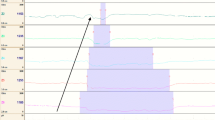Abstract
Twenty-four-hour tracings generated from combined esophageal pH and multichannel intraluminal impedance measurements of 14 infants (nine males, median age 3.5 months) were examined retrospectively. For each tracing, two acid reflux assessment reports were generated using either pH monitoring alone or pH monitoring combined with impedance. Significantly fewer acid reflux episodes were detected using pH monitoring combined with impedance when compared to pH monitoring alone (25.1±4.0 versus 99.9±18.3 episodes/patient, p=.001). Estimates of esophageal acid exposure using pH monitoring alone were two-fold higher (137.4±23.7 versus 66.6±15.9 min/patient, p=.002) than estimates derived using both techniques. Of the total acid reflux episodes detected by pH monitoring alone, 71.8% could not be confirmed by combined pH and impedance. Detection of significant numbers of “pH-only” episodes raises concerns regarding possible over-estimations of acid exposure that may occur when estimates are based solely on esophageal pH monitoring.



Similar content being viewed by others
References
Skopnik H, Silny J, Heiber O, et al. (1996) Gastroesophageal reflux in infants: evaluation of a new intraluminal impedance technique. J Pediatr Gastroenterol Nutr 23:591–598
Wenzl TG, Schenke S, Peschgens T, et al. (2001) Association of apnea and nonacid gastroesophageal reflux in infants; investigations with the intraluminal impedance technique. Pediatr Pulmonol 31:144–149
Colletti RB, Chrisie DL, Orenstein SR (1995) Indications for pediatrics esophageal pH monitoring. Statement of the North American Society for Pediatric Gastroenterology and Nutrition (NASPGN). J Pediatr Gastroenterol Nutr 21:253–262
Vandenplas Y, Belli D, Boige N, et al. (1992) A standardized protocol for the methodology of esophageal pH monitoring and interpretation of the data for the diagnosis of gastroesophageal reflux. Statement of the European Society of Pediatric Gastroenterology and Nutrition (NASPGN). J Pediatr Gastroenterol Nutr 14:467–471
Euler AR, Ament M (1997) Value of esophageal manometric studies in the gastroesophageal reflux of infancy. Pediatrics 59:58–62
Boix-Ochoa J, Lafuentia JM, Gil-Vernet JM (1980) Twenty-four-hour esophageal pH monitoring in gastroesophageal reflux. J Pediatr Surg 15:74–78
Sondheimer JM (1980) Continuous monitoring of distal esophageal pH: a diagnostic test for gastroesophageal reflux in infants. J Pediatr 96:804–807
Vandenplas Y, Sacre L (1987) Continuous 24-h esophageal pH monitoring in 285 asymptomatic infants 0–15 months old. J Pediatr Gastroenterol Nutr 6:220–224
Vandenplas Y, Goyvaerts H, Helven R, et al. (1991) Gastroesophageal reflux, as measured by 24-h pH monitoring in 509 healthy infants screened for risk of sudden infant death syndrome. Pediatrics 88:834–840
Vandenplas Y, Lepoudre R, Helven R (1990) Dependability of esophageal pH-monitoring data in infants on cutoff limits: the oscillatory index. J Pediatr Gastroenterol Nutr 11:304–309
Vandenplas Y, Belli D (1996) Esophageal pH monitoring [letter]. J Pediatr Gastroenterol Nutr 23:337–338
Vandenplas Y, de Pont S, Vandemaele C, et al. (1996) Dependability of esophageal pH monitoring data on software [letter]. J Pediatr Gastroenterol Nutr 23:203–204
Wenzl TG, Moroder C, Trachterna M, et al. (2002) Esophageal pH monitoring and impedance measurement: a comparison of two diagnostic tests for gastroesophageal reflux. J Pediatr Gastroenterol Nutr 34:519–523
Silny J (1991) Intraluminal multiple electric impedance procedure for measurement of gastrointestinal motility. J Gastrointest Motil 3:151–162
Blom D, Mason Rj, Balaji NS, et al. (2001) Esophageal bolus transport identified by simultaneous multichannel intraluminal impedance. Am J Physiol Gastrointest Liver Physiol 280:G457–462
Mousa H, Woodley FW, Metheney M, et al. (2005) Testing the association between gastroesophageal reflux and apnea in infants. J Pediatr Gastroenterol Nutr 41:169–177
Simren M, Silny J, Holloway R, et al. (2003) Relevance of ineffective oesophageal motility during oesophageal acid clearance. Gut 52:784–790
Helm JF, Dodds WJ, Reidal DR, et al. (1983) Determinants of esophageal acid clearance in normal subjects. Gastroenterology 85:607–612
Helm JF, Dodds WJ, Pelc LR, et al. (1984) Effect of esophageal emptying and saliva on clearance of acid from the esophagus. N Engl J Med 310:284–288
Shay S, Tutian R, Sifrim D, et al. (2004) Twenty-four hour ambulatory simultaneous impedance and pH monitoring: a multicenter report of normal values from 60 healthy volunteers. Am J Gastroenterol 99:1037–1043
Peter CS, Wiechers C, Bohnhorst, et al. (2003) Detection of small bolus volumes using multiple intraluminal impedence in pre-term infants. JPGN 36:381–384
Wiener GJ, Richter JE, Cooper JB, et al. (1988) The symptom index: a clinically important parameter of ambulatory 24-h esophageal pH monitoring. Am J Gastroenterol 83:358–361
Breumelhof R, Smout AJ (1991) The symptom sensitivity index: a valuable additional parameter in 24-h esophageal pH recording. Am J Gastroenterol 86:160–164
Vaezi MF, Richter JE (1996) Role of acid and duodenogastroesophageal reflux in gastroesophageal reflux disease. Gastroenterology 111:1192–1199
Harding SM, Guzzo MR, Richter JE (1999) 24-h esophageal pH testing in asthmatics: respiratory symptom correlation with esophageal acid events. Chest 115:654–659
Wenzl TG, Silny J, Schenke S, et al. (1999) Gastroesophageal reflux and respiratory phenomena in infants: status of the intraluminal impedance technique. J Pediatr Gastroenterol Nutr 28:423–428
Lazenby JP, Harding SM (2000) Chronic cough, asthma, gastroesophageal reflux. Curr Gastroenterol Rep 2:217–223
Vela MF, Tutuian R, Sifrim D, et al. (2003) Comparison of pH-metry versus combined multichannel intraluminal impedance and pH (MII-pH) for symptom association studied in symptomatic, acid suppressed GERD patients. Gastroenterology 124:A542
Wunderlich AW, Murray JA (2003) Temporal correlation between chronic cough and gastroesophageal reflux disease. Dig Dis Sci 48:1050–1056
Rosen R, Nurko S (2004) The importance of multichannel intraluminal impedance in the evaluation of children with persistent respiratory symptoms. Am J Gastroenterol 99:2452–2458
Shay S, Richter J (2005) Direct comparison of Impedance, Manometry, and pH probe in detecting reflux before and after a meal. Dig Dis Sci 50:1584–1590
Trachterna M, Wenzl TG, Silny J, et al. (1999) Procedure for the semi-automated detection of gastro-oesophageal reflux patterns in intraluminal impedance measurements in infants. Med Eng Phys 21:195–201
Author information
Authors and Affiliations
Corresponding author
Additional information
This study was funded in part by a grant from the National Institutes of Health (NIH 5R03DK62755-02) (HM) issued on July 1, 2002 (NIH, 900 Rockville Pike, Bethesda, MD).
Rights and permissions
About this article
Cite this article
Woodley, F.W., Mousa, H. Acid Gastroesophageal Reflux Reports in Infants: A Comparison of Esophageal pH Monitoring and Multichannel Intraluminal Impedance Measurements. Dig Dis Sci 51, 1910–1916 (2006). https://doi.org/10.1007/s10620-006-9179-0
Received:
Accepted:
Published:
Issue Date:
DOI: https://doi.org/10.1007/s10620-006-9179-0




